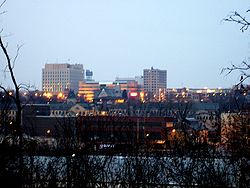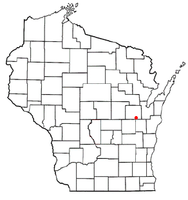Appleton, Wisconsin
City of Appleton, Wisconsin | |
|---|---|
 Appleton skyline from the south bank of the Fox River. | |
 Location of Appleton within Wisconsin | |
| Country | United States |
| State | Wisconsin |
| Counties | Outagamie, Calumet, Winnebago |
| Surrounding Towns | Grand Chute, Little Chute, Menasha |
| Settled | 1835 |
| Incorporated | 2 May 1857 |
| Government | |
| • Type | Mayor-Council |
| • Mayor | Timothy M. Hanna |
| Area | |
| • City | 21.4 sq mi (55 km2) |
| • Land | 20.9 sq mi (54 km2) |
| • Water | 0.5 sq mi (1 km2) 2.2% |
| Elevation | 790 ft (240 m) |
| Population (2005) | |
| • City | 70,217 |
| • Density | 3,355.9/sq mi (1,295.7/km2) |
| • Metro | 360,000 |
| Time zone | UTC-6 (CST) |
| • Summer (DST) | UTC-5 (CDT) |
| ZIP Code | 54911, 54913, 54914, 54915 |
| Area code | 920 |
| FIPS code | 55-02375Template:GR |
| GNIS feature ID | 1560914Template:GR |
| Website | www.appleton.org |
Appleton is a city in Calumet, Outagamie, and Winnebago Counties in the U.S. state of Wisconsin, on the Fox River, 100 miles (161 km) north of Milwaukee. The population was 70,087 at the 2000 census. Appleton is the principal city of the Appleton, Wisconsin Metropolitan Statistical Area, which is included in the Appleton-Oshkosh-Neenah, Wisconsin Combined Statistical Area with a combined population of around 350,000. It is the county seat of Outagamie County.Template:GR
History
Fur traders seeking to do business with Fox River Valley Indians were the first European settlers in Appleton. Hippolyte Grignon built the White Heron in 1835 to house his family and serve as an inn and trading post.
Appleton was settled in 1847 and incorporated as a village in 1853 (John F. Johnston, the first resident, village president) and as a city in 1857 (Amos Storey, Mayor). Early in the 20th century, it adopted the commission form of government. In 1890, 11,869 people lived in Appleton; in 1900, there were 15,085; in 1910, 16,773; in 1920, 19,571; and in 1940, 28,436.
Home to Lawrence University, the city of Appleton grew along with the school. With the financial backing of Amos A. Lawrence, the Lawrence Institute was chartered in 1847. Samuel Appleton donated $10,000 to the newly founded college library, and in appreciation, his name was given to the community.[1]
Appleton has long been home to economic prosperity. The paper industry, beginning with the building of the first paper mill in the city in 1853, has been at the forefront of the development of Appleton. In order to provide electricity to the paper industry, the nation's first hydro-electric central station, the Vulcan Street Plant on the Fox River began operation in Appleton on September 30, 1882. The power plant also powered the Hearthstone House, the first residence in the world powered by a centrally located hydroelectric station using the Edison system.
Shortly thereafter, in August 1886, Appleton was the site for another national first, the operation of a commercially successful electric streetcar company. Electric lights replaced gas lamps on College Avenue in 1912. Appleton also had the first telephone in all Wisconsin, and the first incandescent light in any city outside of the East Coast.
Appleton's Valley Fair Shopping Center, built in 1954, laid claim to being the first enclosed shopping mall in the United States, though this claim is disputed today by others such as Rhode Island's Westminster Arcade, Seattle's Northgate Mall, and Minnesota's Southdale Center. In 2007 most of the structure was demolished, leaving only the east wing and the movie theater.
Appleton was also the childhood home of Harry Houdini, who claimed in interviews to have been born in Appleton on April 6, 1874 even though records show he was actually born on March 24 of the same year.
Demographics

Appleton is the largest principal city of the Appleton-Oshkosh-Neenah CSA, a Combined Statistical Area that includes the Appleton (Calumet and Outagamie counties) and Oshkosh-Neenah (Winnebago County) metropolitan areas,[2][3] which had a combined population of 358,365 at the 2000 census.Template:GR
As of the censusTemplate:GR of 2000, there were 70,087 people, 26,864 households, and 17,676 families residing in the city. The population density was 3,355.9 per square mile (1,295.7/km2). There were 27,736 housing units at an average density of 1,328.0 per square mile (512.7/km2). The racial makeup of the city was 91.48% White, 0.99% African American, 0.57% Native American, 4.61% Asian, 0.03% Pacific Islander, 1.05% from other races, and 1.27% from two or more races. Hispanic or Latino of any race were 2.53% of the population.
There were 26,864 households out of which 35.0% had children under the age of 18 living with them, 53.9% were married couples living together, 8.7% had a female householder with no husband present, and 34.2% were non-families. 27.6% of all households were made up of individuals and 9.1% had someone living alone who was 65 years of age or older. The average household size was 2.52 and the average family size was 3.13.
In the city the population was spread out with 27.4% under the age of 18, 9.7% from 18 to 24, 31.8% from 25 to 44, 19.7% from 45 to 64, and 11.3% who were 65 years of age or older. The median age was 34 years. For every 100 females there were 96.7 males. For every 100 females age 18 and over, there were 93.7 males.
The median income for a household in the city was $47,285, and the median income for a family was $57,097. Males had a median income of $40,459 versus $25,890 for females. The per capita income for the city was $22,478. About 3.3% of families and 5.5% of the population were below the poverty line, including 7.1% of those under age 18 and 4.8% of those age 65 or over.
Transportation
The city is a member of Valley Transit, a network of bus lines crisscrossing the Fox Valley.
Commercial air service is provided at Outagamie County Regional Airport.
Roads
The primary roads into the metro Appleton area are US-41 and US-10. US-41 runs north-south on the west side of the city, and turns east-west across the north side of the city. US-41 connects to Green Bay to the northeast and Oshkosh, Fond du Lac, and Milwaukee to the south. W-441 loops off US-41 across the south and east sides of the metro Appleton area. US-10 is an east-west highway that connects to Manitowoc to the east, and Stevens Point/Wausau to the west.
WIS-125 provides access from US-41 to downtown Appleton. Other secondary state highway into the Appleton metro area include WIS-47, WIS-96, WIS-15. Roads that route exclusively through suburbs of Appleton include US-45, WIS-55, WIS-114, and WIS-76.
Education
Appleton is served by the Appleton Area School District, which has three high schools, four middle schools, fifteen elementary schools, and sixteen charter schools. The district's three public high schools are Appleton East, Appleton North and Appleton West. Xavier High School is the city's Roman Catholic high school and Fox Valley Lutheran High School is its Lutheran high school.
Appleton is home to Lawrence University, a private liberal arts college, and the Fox Valley Technical College. The University of Wisconsin-Fox Valley, a two-year collegiate campus of the University of Wisconsin System is located in nearby Menasha, Wisconsin.
The city and surrounding area are served by the Appleton Public Library. The library was chartered by the city in 1897 and as of 2007 has a collection of nearly 400,000 volumes.
Economy
- Kimberly Clark
- West Business Services
- Pierce Manufacturing
- Thrivent Financial for Lutherans
- Appleton (formerly known as Appleton Papers)
Health care
Tourism
Appleton tourist attractions include the Hearthstone House, an 1881 four-story mansion that was the first house in the world to be powered by hydroelectricity. The Museum At the Castle contains exhibits on Fox River Valley history, including a gallery showcasing Edna Ferber, a Harry Houdini exhibit, and other traveling exhibits. The Paper Discovery Center has historic paper-making machines on display and an exhibit on the history of paper.
Notable residents
- Gary Arndt, travel photographer and writer
- Rocky Bleier, football player
- John Bradley, Iwo Jima Navy flag-raiser
- Cory Chisel, musician
- Willem Dafoe, actor
- Edna Ferber, author
- William Norman Grigg, author
- J. P. Hayes, golfer
- Harry Houdini, magician
- Roger Jenkins, hockey player
- Steve Kagen, U.S. Congressman
- Ron Kostelnik, football player
- Tony Kubek, baseball player and announcer
- Jeff Loomis, guitarist
- Joseph McCarthy, senator
- Steve Millar, lead singer/guitarist for The Rest
- John Benjamin Murphy, surgeon
- William Beverly Murphy, president of Campbell Soup Company
- Brad Smith, vice president of Microsoft
- Greta Van Susteren, FoxNews television anchor
- Walter B. Wriston, banker
- Terry Zwigoff, filmmaker
Points of interest
- Appleton Art Center
- Fox Cities Performing Arts Center
- Fox River Mall (in nearby Grand Chute)
- Fox Valley Technical College
- Gardens of the Fox Cities
- Goodland Field
- Hearthstone Historic House Museum
- The History Museum at the Castle
- Lawrence University
- Wisconsin Timber Rattlers (in nearby Grand Chute)
-
DOT sign on WIS 125
-
Looking east at Downtown Appleton
-
Looking east at Downtown Appleton
-
Looking west at Downtown Appleton
-
Looking east down on downtown Appleton
-
Looking west down on downtown Appleton












